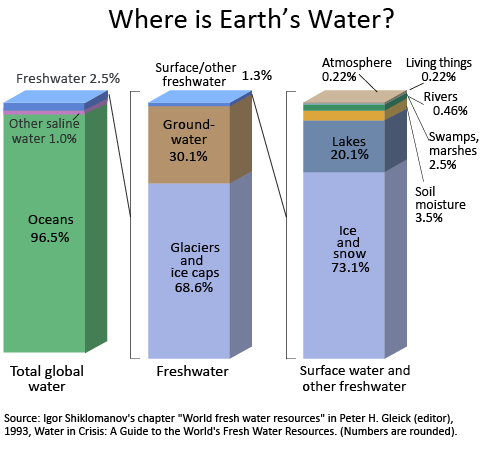|
97% of the water on the Earth is salt water only 3% is fresh water; slightly over two thirds of this is frozen in glaciers and polar ice caps. The remaining unfrozen freshwater is found mainly as groundwater, with only a small fraction present above ground or in the air.
Source: Water resources - Wikipedia
Estimated Use of Water in the United States in 2005.
About 410 billion gallons per day (Bgal/day) in 2005. 85% is fresh water.
This total is slightly less than the estimate for 2000, and about 5 percent less than total withdrawals in the peak year of 1980.
Groundwater 79.6 Bgal/day
Fresh Surface-water 270 Bgal/day
Thermoelectric-power generation 201 Bgal/d
Irrigation 128 Bgal/d
Public supply 44.2 Bgal/d
Self-supplied industrial withdrawals 18.2 Bgal/d
Mining 4.0 Bgal/d
Livestock 2.1 Bgal/d
Nearly 30 percent of all fresh surface-water withdrawals in 2005 occurred in five States. In California, Idaho, Colorado, Texas and Illinois.
Source: usgs.gov
Where is Earth's water? USGS Water-Science School

What You Can Do
Indoors
Laundry Room
- Use the washing machine for full loads only to save water and energy
- Install a water-efficient clothes washer Save: 16 Gallons/Load
Kitchen
- Run the dishwasher only when full to save water and energy.
- Install a water- and energy-efficient dishwasher. Save: 3 to 8 Gallons/Load.
- Install aerators on the kitchen faucet to reduce flows to less than 1 gallon per minute.
Bathroom
- Install low-flow shower heads. Save: 2.5 Gallons
- Take five minute showers instead of 10 minute showers. Save: 12.5 gallons with a low flow showerhead, 25 gallons with a standard 5.0 gallon per minute showerhead.
- Fill the bathtub halfway or less. Save: 12 Gallons
- Install a high-efficiency toilet. Save: 19 Gallons Per Person/Day
- Install aerators on bathroom faucets. Save: 1.2 Gallons Per Person/Day
- Turn water off when brushing teeth or shaving. Save: Approximately 10 Gallons/Day
- Don't use the toilet as a wastebasket.
Source:Save Our H2O.org
Outdoors
Landscape - Accounts for 50% or moer in some places.
- Water early in the morning or later in the evening when temperatures are cooler. Save: 25 gallons/each time you water
- Check your sprinkler system frequently and adjust sprinklers so only your lawn is watered and not the house, sidewalk, or street. Save: 15-12 gallons/each time you water
- Choose a water-efficient irrigation system such as drip irrigation for your trees, shrubs, and flowers. Save: 15 gallons/each time you water.
- Water deeply but less frequently to create healthier and stronger landscapes.
- Put a layer of mulch around trees and plants to reduce evaporation and keep the soil cool. Organic mulch also improves the soil and prevents weeds. Save: 20-30 gallons/each time you water/1,000 sq. ft.
- Plant drought-resistant trees and plants. Save: 30- 60 gallons/each time you water/1,000 sq. ft
Don't Overwater
- One easy way to cut down how much water you use outdoors is to learn how much water your landscaping actually needs in order to thrive. Overwatering is one of the most common mistakes people make. To understand how much water your landscaping really needs, learn more about evapotranspiration (ET) here.
- For Southern California residents, try this easy watering calculator to help determine how much you should be watering outside.
Get Smart
- If you really want to be a sophisticated water user, invest in a weather-based irrigation controller--or a smart controller. These devices will automatically adjust the watering time and frequency based on soil moisture, rain, wind, and evaporation and transpiration rates. Check with your local water agency to see if there is a rebate available for the purchase of a smart controller.
Know Your Climate - One way to save water outdoors is to plant the right plants for your climate. Here are some tools to help you learn how to be a water-wise gardener:
- Explore the Save Our Water Water-Wise Garden Tool to learn what plants and flowers will flourish in your neighborhood.
- Sunset Magazine's Plant Finder is another great tool.
- Learn more about gardening in a Mediterranean climate here.
Outdoor Cleanup - Water is often a go-to tool for outdoor clean-up jobs.
- Use a broom to clean driveways, sidewalks and patios. Save: 8-18 gallons /minute.
- Wash cars/boats with a bucket, sponge, and hose with self-closing nozzle. Save: 8-18 gallons/minute.
- Invest in a water broom. If you have to use water to clean up outside, a water broom will attach to your hose but uses a combination of air and water pressure to aid cleaning. Water brooms can use as little as 2.8 gallons per minute (gpm) to remove dirt, food spills, leaves, and litter from concrete and asphalt while a standard hose typically uses 5 to 20 gpm.
Links:
Welcome to Save Our Water | SaveOurH2O.org
What We Can Do | SaveOurH2O.org
Water resources - Wikipedia
USGS Water Resources of the United States
USGS Water Use in the United States
USGS Fact Sheet: Summary of Estimated Water Use in the United States in 2005
USGS New Jersey: Water Use in New Jersey
Uses of Natural Water Resources | National Geographic
Lawn Irrigation
Arctic Sea Ice 2011, 2012 | Open Mind
Return to Environment
last updated 10 May 2013
| 